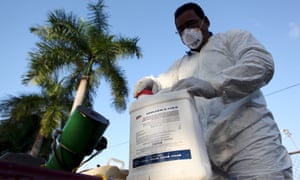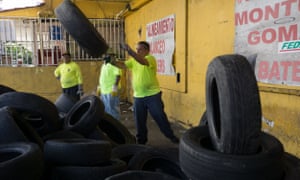Puerto Rico officials struggle to translate Zika virus fears into action
Every time it rains in San Juan, Dr Brenda Rivera-García walks around her home emptying containers of standing water, probably wearing long sleeves, and almost certainly wearing mosquito repellent. Rivera-García is the state epidemiologist in Puerto Rico, a woman tasked with tracking every single Zika-infected pregnant woman in the US territory.
Less than two weeks after the US health and human services administrationdeclared the spread of Zika on the island an epidemic, Rivera-García said it’s not frustration or anger that overtakes her when she adds a new woman’s name to a list of roughly 700 confirmed to be infected with the disease.
It’s sadness.
“Every time I have to add a pregnant woman to that list, I just think of what’s going to be of this pregnancy,” she said, her eyes visibly wet. “What’s going to be of this child later on, and, it’s, it’s – it breaks my heart.”

‘False alarms’
Denisse Velázquez, 36, stood under the shade of a tree in Old San Juan, one of the hardest-hit municipalities, as she said that the government “created false alarms”.
Juan Martínez, 43, said that with “all these diseases we have seen, it’s something normal”, referring to periodic outbreaks of dengue the island has struggled with since the 1980s, and the recent chikungunya outbreak. “In the Caribbean there has always been mosquitoes.”
Even tourism officials have reinforced the view that the Zika risk has been overblown.
“From the very beginning the numbers that were given were based on projections. The reality is that as of today, less than half of 1% of the population has the virus,” Clarisa Jiménez, CEO of the Puerto Rico Hotel and Tourism Association, told CNBC’s Squawkbox. “The only issue here is if you’re pregnant.”
Jiménez focused on the roughly 10,600 Puerto Ricans who had, at the time, been diagnosed with Zika by the CDC. The figure is an underestimate, because four out five infected people have no symptoms and probably do not know they have the virus.
Now, near the end of August, the health department of Puerto Rico and the CDC have diagnosed 12,800 Zika infections, including more than 670 in pregnant women, believed to represent only a fraction of actual cases.
So far, only one child has been born with microcephaly. But experts expect that number to increase dramatically in coming months, particularly from September to December.
Health professionals believe the most dangerous time for a pregnant woman to be infected is in her first trimester, though more research is needed. Those pregnancies are expected to begin coming to term this fall.
“Right now, most of the births we have seen are among second and third trimester infections,” said Rivera-García. “For us, it’s not just a number. There’s a family behind that number.” Doctors suspect that even these cases, which are less dramatic in appearance, could result in problems that won’t manifest until much later.
The island’s timetable of epidemic infection is about one year behind Brazil’s. In December 2015, as cases of microcephaly began to surge in Brazil, cases of locally acquired infections were just beginning to show up in Puerto Rico.
“When you’re involved in major epidemics, and particularly this one for some reason, I’ve been unable to disconnect,” said Dr Francisco Alvarado-Ramy, a senior CDC official and native Puerto Rican who helps lead the federal government’s response to the epidemic. He is stationed at the Dengue Branch, an outpost in San Juan established to combat another virus spread by the same mosquito as Zika, the aggressive Aedes aegypti.
“The moment that I go to sleep to the moment that I wake up, my mind seems to be around Zika all the time, trying to think if there’s any other thing we can do,” he said.
“When something goes wrong, it’s also a very fast way down, downstairs in terms of your emotional wellbeing. We’re trying to prepare our staff, as well, if we start seeing a lot of people with bad outcomes how to handle that emotionally.”
Cat, dog, mosquito
“We have in Puerto Rico a dog, a cat and a mosquito,” said Carmen Deseda, the former state epidemiologist who battled several epidemics of dengue, a hemorrhagic fever that can incapacitate a person for weeks. “The problem is not the mosquito, it’s the virus.”
Deseda expressed a view common among Puerto Ricans: the mosquito is here to stay, fumigating won’t work, so the government better find some other way to deal with this.
She was among many prominent opponents of fumigating the island with an insecticide called Naled, a solution proposed by the CDC and used on about 6m acres of land each year in Florida. Many residents were outraged that the federal government would, in their view without permission, spray chemicals over the island.
“When they said that I was very upset,” said Miguel Pellot, 48, the owner of a smoothie stand called Fruta Fruit in San Juan. “¿Cómo se dice, una falta de respeto?” he said, asking how to express lack of respect in English.
“For people here, this is nothing new. We’ve had mosquitoes here since we were born,” Deseda said. “They don’t feel threatened by the mosquito, because it’s been always with them.”
Deseda said government fumigation encourages apathy among the population. “The government is doing something so they don’t have to anything.”
Ceda Vélez, a 36-year-old woman working a juice stand near San Juan’s cruise ship ports said she was in favor of government fumigation.
“We use repellent, but at least it would help with where the mosquitoes breed, to kill the mosquitoes,” she said in Spanish. “I worry.”
Puerto Rico won’t fumigate with Naled from planes, as Florida does. And even if Puerto Rican authorities decided to fumigate street-side from trucks, only about 12 vehicles on the island are outfitted to spray for mosquitoes. Regional resistance to insecticides has also confounded eradication efforts.
Some residents believe the island was a guinea pig for past federal government experiments, that Zika was mild and posed no risk, that they weren’t going to stop “living”, or were simply misinformed about how to prevent exposure.
“I had, yes, but I drink Tylenol, y ya,” said Naara Nieves, 39, who stood outside at noon in San Juan proselytizing, a gregarious evangelist for Jehovah’s Witnesses. “I think the women who are pregnant, is bad, but for me, no.”
Marylin Vigo, who was visiting her sister on the island from Brooklyn, New York, said her relatives called her “paranoid” for even slathering on mosquito repellent.
“She goes, ‘Ugh! That doesn’t mean you’re going to get Zika, because of mosquito bites,’” Vigo said, describing her sister’s reaction. This is despite her sister’s belief that Vigo’s 29-year-old nephew just contracted the virus.
A cultural gulf
One of the most cited differences between Puerto Rico and the mainland is the lack of screened windows and air conditioning, which hamper the spread of mosquito-borne diseases in places like Texas.
Tropical breezes course uninhibited through flung-open doors, patios and unscreened louvre window shades. The open roofs of Spanish-influenced architecture let in rain drained away by a floor grate.
“If you go to the communities, people love to sit out on their patio, play dominoes, play music, have a barbecue, and that’s difficult to do in a screened-in porch, or take advantage of the Caribbean leeward breezes,” said Rivera-García. “It certainly changes your way of life.”
So the Puerto Rico department of health is focused on behavioral and cultural change.
River-García said past epidemics of diseases with severe symptoms like chikungunya have not driven people to engage in practices like wearing repellent and investing in screened windows.
“That’s why we – from the get-go in January – we said, ‘OK, we need behavioral science studies. We need to understand what will be that one driver, or the drivers, to effect behavior change.”
Even for those who might want screens, it could be a real burden.
Nearly half the population, 46%, lives in poverty. The average per-capita income is just $19,600, meaning an air-conditioned bedroom may beunattainable.
A raft of other science conducted on the island is looking at other solutions. Children of Zika-infected mothers will be followed until they are three years old. Alvarado and his team collect blood and placenta samples from Zika-infected women who give birth and miscarry.
Traps are being re-engineered at the Dengue Branch, including the promising, pesticide-free innovation of a bucket that uses fermenting hay and water to trap mosquitoes.
“It drives me to keep trying and see where can we improve, what else can we do,” said Rivera-García. “I think for all the responders both local and stateside with many Puerto Ricans in various areas of expertise – they’re coming back, donating their time, or asking for deployments in Puerto Rico.”

A quarter of the population may have the disease by the end of mosquito season, but efforts to control it have been thwarted by apathy and misinformation
Puerto Rico officials struggle to translate Zika virus fears into action




